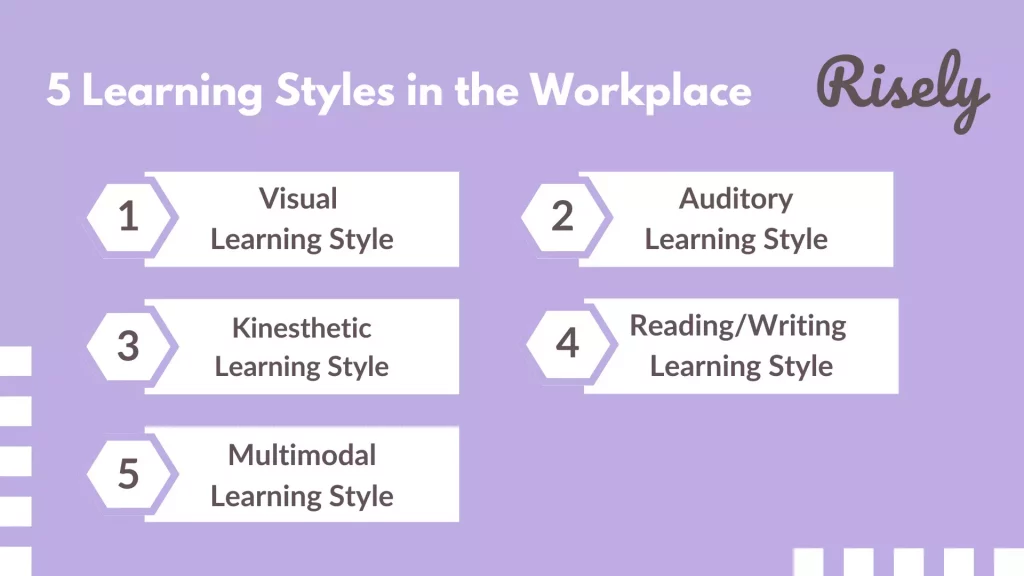5 Learning Styles In The Workplace Sound Like Chaos. Here’s How To Manage Them
Have you ever struggled to understand or remember something, even after much effort? Do you feel you learn better when you see a diagram or hear someone explain it? These are all signs of different learning styles. Each person has a unique way of processing information and making sense of the world around them. Understanding these learning styles helps you craft the most effective learning and development interventions at work. In this blog, we will discuss different types of learning styles, the five types of learners, and how you can accommodate different learning styles in the workplace. Read on to discover more about your team members’ different learning styles and learn how to use them to your advantage.What are Learning Styles?
When we talk about learning styles, we refer to the different ways people process and retain information. Each individual has a unique way of processing and retaining information, defined by their learning style. For example, some people learn best by seeing information presented visually, while others absorb information better through auditory means. Still, others prefer kinesthetic learning and thrive when given hands-on activities that engage them physically with the material. It’s essential to recognize that there are many types of learners, and understanding your team’s learning style is crucial to ensuring that your team grows exponentially. The idea of varied learning styles is an old one. It got popular with the VARK model by Neil Fleming. VARK stands for Visual, Auditory, Reading/Writing, and Kinesthetic, representing the four main learning styles. Research studies have questioned the validity of specific models, suggesting that the evidence supporting tailored teaching based on learning styles was limited. Some argued that learners may benefit from various instructional methods rather than a rigid adherence to a single style. With time, our understanding of “intelligence” has also evolved and expanded to include more. From the static idea of intelligence limited to mathematical and verbal ability at best, we have arrived at the concept of multiple intelligences, wherein social, emotional, and cultural intelligence are getting their due recognition. Now, when so many different minds learn and other areas must be taught, how can your methods be the same?Are learning styles important for L&D managers?
Short answer: Yes, learning styles are essential for L&D professionals. Long answer, let’s see: Understanding the learning styles of individual team members helps managers tailor their approach to training and development, which ultimately leads to better performance and job satisfaction. Understanding your team’s learning style is crucial to achieving success. Primarily, understanding learning styles at work helps L&D in these ways:- Improved communication: When L&D teams understand the learning styles of their team members, they can communicate more effectively. For example, a visual learner benefits from charts and diagrams, while an auditory learner prefers verbal explanations. By catering to the individual learning styles of team members, managers can ensure that everyone is on the same page and working towards the same goals.
- More effective training and development: By understanding the learning style of their team members, managers can develop more effective training and development programs. For example, a kinesthetic learner benefits from hands-on training and simulations, while a reading/writing learner prefers written instructions or notes. By considering individual learning styles, L&D teams can create programs that better resonate with their team members and help them learn and grow.
- Increased job satisfaction: When L&D teams take the time to understand the learning style of their team members and tailor their approach to training and development, team members are likely to feel more supported and valued. This can lead to increased job satisfaction, which in turn can boost morale and productivity.
- Increased creativity and innovation: By understanding the learning style of their team members, managers can encourage more creativity and innovation. For example, a visual learner will be more likely to develop a new idea after seeing a picture or a chart. In contrast, an auditory learner will be more likely to generate ideas after a group discussion or brainstorming session. By catering to the individual learning styles of team members, managers can create an environment that fosters creativity and innovation, leading to better problem-solving and idea generation.
The 5 Types of Learners You Meet at Work
Understanding the different learning style is crucial for anyone seeking to enhance their learning experience. Learning styles are unique to each individual, and understanding the different types of learners can help facilitate effective learning in various settings. In addition, recognizing these different styles of learning can help create a conducive environment for varied kinds of learners.- Visual learners: These learners prefer to see things to understand them.
- Auditory learners: These learners prefer to hear something to understand them.
- Reading/writing learners: These learners like reading and writing to understand things.
- Kinesthetic learners: These learners prefer to learn through hands-on experiences and physical activity.
- Multimodal learners: These learners do not have a preferred learning style and benefit from a combination of different approaches.
Learning styles: Definition and examples

Visual Learning Style
Visual learners prefer to process information through images, diagrams, and other visual aids. They learn best when they see information presented in a clear and organized way. Visual learners might benefit from training materials that include charts, graphs, or videos in the workplace. They also appreciate a well-designed and visually appealing presentation. On the other hand, visual learners struggle with text-heavy materials or instructions that are not presented in a clear and organized way. Visual Learning Style example: A visual learner prefer to receive information through a chart or graph. For instance, if a sales team is learning about their monthly sales performance, a visual learner benefit from a chart that shows their progress throughout the month.Auditory Learning Style
Auditory learners learn best through sound. They prefer to listen to information and benefit from lectures, podcasts, or discussions. In the workplace, auditory learners appreciate team meetings, conference calls, or one-on-one conversations with their manager. However, they struggle with written materials or instructions not explained verbally. Auditory Learning Style example: An auditory learner prefer to receive information through a lecture or presentation. For instance, if a team is learning about a new product launch, an auditory learner benefit from a presentation explaining the new product’s features and benefits.Kinesthetic Learning Style
Kinesthetic learners learn best through movement and touch. Therefore, they prefer actively engaging in learning and benefit from hands-on activities, simulations, or role-playing exercises. In the workplace, kinesthetic learners appreciate opportunities to participate in training programs or workshops that allow them to practice new skills. However, they struggle with sedentary work or training programs that do not include interactive components. Kinesthetic Learning Style example: A kinesthetic learner prefer to learn through hands-on experience. For instance, if a team is learning a new software program, a kinesthetic learner benefit from a training session with interactive exercises or simulations.Reading/Writing Learning Style
Reading/writing learners prefer to learn through written materials. They learn best when information is presented in a written format, such as through books, articles, or handouts. In the workplace, reading/writing learners appreciate written instructions or manuals. However, they struggle with oral presentations or training programs that do not include written materials. Reading/Writing Learning Style example: A reading/writing learner prefer to receive information through written materials. For instance, if a team is learning about a new company policy, a reading/writing learner benefit from a written manual or handbook that outlines the policy.
Multimodal Learning Style
Multimodal learners prefer to learn through a combination of different learning styles. As a result, they benefit from various training materials, such as visual aids, written materials, and hands-on activities. In the workplace, multimodal learners appreciate training programs that include various learning activities. Conversely, they struggle with training programs that focus on only one type of learning style. Multimodal Learning Style example: A multimodal learner benefit from various learning activities. For instance, if a team is learning about a new project management tool, a multimodal learner help with a combination of written materials, interactive exercises, and visual aids.Accommodating Different Learning Styles in the Workplace
Managers must accommodate different learning styles in the workplace to ensure that all team members can learn and grow to their fullest potential. Here are some ways managers can accommodate different styles of learning in the workplace:- Identify team members’ learning style: The first step is to identify the learning style of each team member. This can be done through observation, feedback, and assessments. There are various tools and reviews available that can help managers identify the learning styles of their team members.
- Offer multiple training methods: Managers can offer a variety of training methods to cater to different learning styles. For example, visual learners benefit from videos or infographics, while auditory learners prefer podcasts or webinars. Kinesthetic learners benefit from hands-on training or simulations, while reading/writing learners choose written instructions or notes.
- Use a blended approach: A blended approach that combines various training methods can effectively accommodate different learning style. For example, a training program can include videos, written instructions, group discussions, and hands-on activities to cater to all learners.
- Use adaptive learning: Create a personalized learning approach that suits the needs of your team members using the adaptive learning method. It enables managers to cater to varying learning styles across teams.
- Encourage team members to identify their learning style: Encouraging them to identify their style of learning can be empowering and help them take ownership of their learning. Managers can provide resources and support to help team members identify their learning styles and find training methods that work best for them.
- Feedback and support: Managers can provide feedback and support to team members to help them improve their learning and development. For example, if a team member struggles to understand a concept, the manager can offer additional resources or one-on-one support to help them master the material.
Conclusion
Understanding learning style is crucial to creating a balanced and effective learning environment. By accommodating different styles of learning in the workplace, you can ensure that your employees are engaged, motivated, and able to retain new information more effectively. Whether providing varied training materials or encouraging group collaboration, there are many ways to create an inclusive and personalized learning experience for everyone.Understand your team and their learning styles better with active listening,
Improve your active listening skills with the help of the free active listening assessment for managers.
Frequently Asked Questions
What are the 3 types of learning styles?
The three types of learning styles are visual, auditory, and kinesthetic. Visual learners prefer to learn through images and graphics, auditory learners through hearing and speaking, and kinesthetic learners through hands-on activities and movement. Some people may have a combination of these learning styles.
How to accommodate different learning styles in the workplace?
To accommodate different learning styles in the workplace, employers can offer a variety of training methods, such as visual aids, hands-on demonstrations, and interactive group activities. Additionally, employers can provide opportunities for employees to give and receive feedback, which can help them identify their learning styles and tailor their approach accordingly.
Are learning styles important?
Learning styles are essential because individuals have unique preferences for processing and retaining information. Therefore, accommodating different learning styles can enhance learning outcomes and increase employee engagement and satisfaction. However, it is also essential to recognize that learning styles are just one factor that can impact learning and that individuals may have different learning styles for various tasks or situations.
Other Related Blogs
How to Create a Course with AI: A Guide for L&D Professionals
How to Create a Course with AI: A Guide for L&D Professionals According to a McKinsey survey(1), only 11% of business leaders believe their leadership development initiatives yield meaningful results.…
How to build a Learning and Development Action Plan ft Katie Greenwood
How to build a Learning and Development Action Plan ft Katie Greenwood Does your company’s Learning and Development (L&D) strategy feel like more “guessing” than “winning”? You’re not the only…
Generative AI for Learning and Development: Getting Started
Generative AI for Learning and Development: Getting Started In 2024, organizations spent $401 billion globally on corporate training(1), yet 70% of employees report feeling unprepared for the future of work…
Future proofing a learning strategy for organizations with Inna Horvath
Future Proofing a Learning Strategy for Organizations with Inna Horvath With the advent of AI, everyone’s anticipating changes. L&D leaders in charge of building a learning strategy for organizations are…


